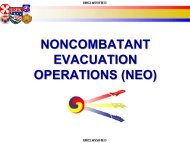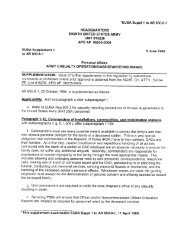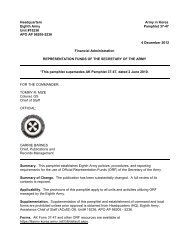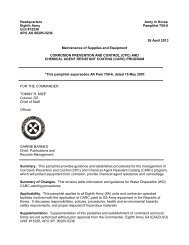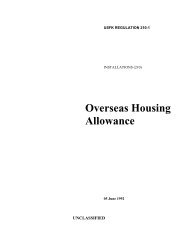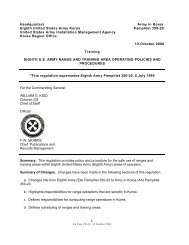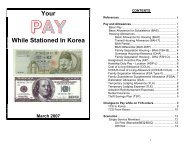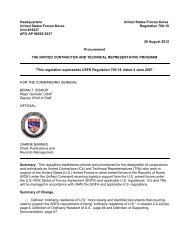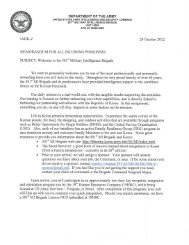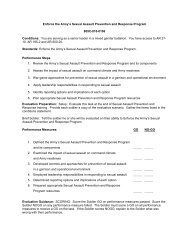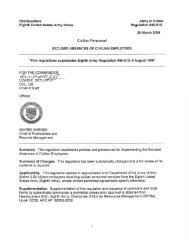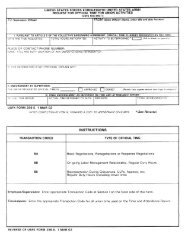CAS3 Staff Officer Guide - U.S. Army
CAS3 Staff Officer Guide - U.S. Army
CAS3 Staff Officer Guide - U.S. Army
You also want an ePaper? Increase the reach of your titles
YUMPU automatically turns print PDFs into web optimized ePapers that Google loves.
73<br />
<strong>Staff</strong> <strong>Officer</strong>'s <strong>Guide</strong><br />
9 Correspondence<br />
General<br />
a. AR 25-50, Preparing and Managing Correspondence, establishes the basic formats for<br />
standard <strong>Army</strong> correspondence: the informal memorandum, the formal memorandum, and the letter.<br />
(1) Informal Memorandum. Use the informal memorandum format for routine<br />
correspondence internal to organizations within Fort Riley and the 52d ID (M).<br />
(2) Formal Memorandum. The formal memorandum is used for correspondence that is sent<br />
outside the headquarters, the command, the installation, or similarly identifiable organizational<br />
elements within the DOD; for routine correspondence to Federal Government agencies outside the<br />
DOD; for notification of personnel actions, military or civilian; and for showing appreciation or<br />
commendation to DA employees and soldiers. Use the formal memorandum for correspondence sent<br />
off the installation and for policy documents. You may also use the formal memorandum for personal<br />
correspondence sent through the chain of command to individuals.<br />
(3) Letters. Use letters for correspondence to the President or Vice President of the United<br />
States, members of the White House staff, members of Congress, Justices of the Supreme Court,<br />
heads of departments and agencies, State governors, mayors, foreign government officials, and the<br />
public. Letters may also be used for correspondence to individuals outside the department or agency<br />
when a personal tone is appropriate, for official personal correspondence by military and civilian<br />
personnel, and for letters of welcome, appreciation, commendation, and condolence.<br />
b. This <strong>Staff</strong> <strong>Officer</strong>s <strong>Guide</strong> does not supplement or modify the basic regulation for use of these<br />
formats. This <strong>Guide</strong> provides guidance and tips regarding the preparation and use of the standard<br />
<strong>Army</strong> formats, as well as the preparation and use of other types of documents internal to Fort Riley<br />
and the<br />
52d ID (M).<br />
c. Action officers are responsible for the complete staff action to include: proper use of<br />
grammar, spelling, and punctuation; and compliance with standard format guidance.<br />
d. DA Pamphlet 600-67, Effective Writing for <strong>Army</strong> Leaders, provides specific instructions on<br />
effective <strong>Army</strong> writing that transmits a clear message in a single, rapid reading and is generally free<br />
of errors in grammar, mechanics, and usage.<br />
Correspondence Standards<br />
a. The correspondence standard for Fort Riley and the 52d ID (M) is Microsoft (MS) Word,<br />
Times New Roman 12 font, left justification.<br />
b. Generally speaking, margins are 1 inch left, right, top, and bottom. However, letter and<br />
letterhead margins can be different. Look up the margin requirements for each type of document in<br />
AR 25-50 and in this <strong>Staff</strong> <strong>Officer</strong>s <strong>Guide</strong>. Adjust the default settings in Microsoft Word as<br />
appropriate.<br />
c. Print documents on a laser-quality printer.<br />
© 2005 <strong>CAS3</strong> For Instructional Purposes Only<br />
Compiled by www.<strong>Army</strong>Toolbag.com



